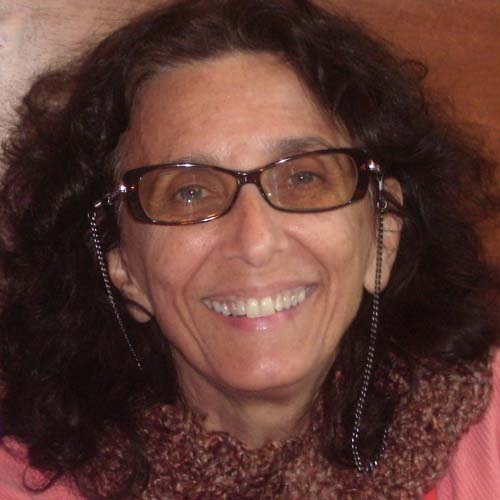Authenticity: The Impact of a Sign Language Interpreter’s Choices
Stephanie Feyne explores how the choices made by sign language interpreters affects the perception of Deaf people and how interpreters can present a more “authentic” representation of someone’s message.
You can find the PPT deck for her presentation here.
Authenticity
(The examples in this article are of female interpreters and male Deaf individuals in order to accommodate the gendered demands of English pronouns. This may or may not reflect the actual identities of the people involved.)
In this presentation I will be discussing the concept of “authenticity” during interpretation – what it means and why I use this term.
We interpreters know we are responsible for the transmission of the content of speakers’ messages. An additional responsibility is to express the manner in which one person speaks, which allows the other participant to get a glimpse of who the person is.
Last month a Deaf teacher was presenting in front of a group of hearing children. I was interpreting for him. He told them to copy his notes from the board. I interpreted that in the first person, “copy what I wrote…”
A first grade girl spun her head towards me in disbelief. “You didn’t write anything!” she exclaimed. I agreed with her, that I hadn’t, but I then explained that our job as interpreters is to say what the Deaf person said. She thought about this for a second and replied, “Oh, you’re pretending to be him.”
That struck me as a profound statement. And, of course, she was absolutely correct! That’s exactly what we interpreters do – we take on the identity of the Deaf person as we represent their message so that the hearing person knows who they are.
We speak not “FOR” the Deaf party but “AS” the Deaf party. Our utterances are expressed in the first person: “I don’t understand my homework”, “I want to work for your company”, “My daughter is sick.”
Say What They’re Saying
Many hearing people assume that interpreters are experts and our work product is a verbatim rendition of the utterances of Deaf people.
I interviewed several hearing non-interpreters. I asked them what they thought interpreters did. One response summed it up, “You’re supposed to be just saying what they’re saying. ” I then asked them if they believed that every “um”, “uh”, and “you know” uttered by interpreters was originated by the Deaf person – and they replied affirmatively. This is an interesting belief about how interpreters function.
I am currently studying linguistic anthropology, a field that examines language and interaction, from which I have learned new theories that I now apply to interpretation.
I want to share some theory about authenticity and about identity:
Bucholtz and Hall (and other theorists) are saying that not only do we express our own identity through the way we talk but also the person talking with us uses their entire lifetime of experience communicating to take in what we say and how we express it and construct their own perception of our identity. They explore whether we are similar to or different from others who communicate that way. And throughout the interaction, their construct continuously is reified, refined or altered. Included in this situated identity are social factors, power differential, etc., but also the continuous unfolding of the individual in the place and time of the interaction; thus, the construct of identity is progressively negotiated and refined over time.
The second point from Bucholtz and Hall is what really knocked me out: that even as we talk in ways that represent our personal identity, listeners assess our language to see if we are genuine and credible.
When I first read about this I realized that this, indeed, is the task of sign language interpreters. We attempt to express the message of the Deaf person in such a manner that the hearing person sees him or her as genuine and credible.
Brad Davidson, a linguistic anthropologist, studied interactions of hearing Spanish/English interpreters in hospitals in California. Davidson claims that interpreters may function as “gatekeepers.” His study delineated how Spanish interpreters in hospitals are gathering information prior to the doctor’s arrival in the consult room. They then answer the doctor’s questions directly. They are decide when or if Spanish speakers can talk or even ask questions. In addition, he found that the interpreters he studied would limit or refuse to interpret responses if they thought the patient’s answer was off point. He claimed that as a result doctors might see these patients as passive. This means the actions of those interpreters may be contributing to doctors’ perceptions of their patients’ identities.
I wondered if sign language interpreters also contribute to the hearing perception of the identity of Deaf people and am conducting research on that topic.
Natural Conversation
To explore interpreted interaction I think it is helpful to first examine direct interaction between two people, A and B. They usually take turns. The flow of conversation often feels natural. They make eye contact. They may laugh. Their talk may overlap. One of them might interrupt the other, then their conversation continues.
However, when an interpreter is present the conversation is different. The conversation flows from A to the interpreter then to B, and when B replies the comment again goes to the interpreter before getting to A.
They make eye contact, but now there is more of a dance – with all the participants trying to catch the other’s gaze at some point, including the interpreter. Often the hearing party wants to look at the interpreter, because that is the source of the spoken word.
If they laugh, there is a ripple effect, say, first from the Deaf person, then perhaps the interpreter, and finally the hearing party if the interpreter has expressed it in a humorous manner in English. We hope we are interpreting in an “authentic” manner.
They may overlap, but the interpreter tries to control the flow and ask them not to speak at the same time. And they interrupt – at which point decisions have to be made. Who will win the interruption? Who decides?
If the hearing person tries to interrupt it is often fairly simple to stop a Deaf signer. We have eye contact. We know the polite rules for interrupting in sign. What about when a Deaf person interrupts a hearing person? What decisions do we make? What are our norms and beliefs about interrupting hearing speech? How do they affect our interpreting choices?
I happened to be present at a meeting with two Deaf and a dozen or so hearing participants and one certified interpreter. The discussion was heated. Everyone was calling out, interrupting the others, changing topics, etc. I noticed the interpreter signing everything that was spoken, but not voicing any of the comments of the Deaf participants. No matter how many times they tried to interject she steadfastly continued signing the hearing comments. I wondered what the reason could be for her choice.
(Don’t worry, eventually the Deaf participants got their points in.)
After the meeting wrapped up, I asked the interpreter why she chose not to voice when the Deaf participants tried to interject. This interpreter was open to reflecting on her work. After a moment she replied that she had not called out because “It’s rude to interrupt.”
This is an amazing example of how our tacit norms for communication can control our interpreting choices. When the hearing parties interrupted each other she had no problem interpreting those comments into ASL. But for her to speak out and actually interrupt the hearing participants when the Deaf people wanted to interpose their ideas would have meant SHE was rude, and at that moment her norms for polite conversation overrode her interpreting mandate.
I must clarify that she was a skilled interpreter. She had no deliberate intent to oppress Deaf people or to curtail their communicative rights. She just had not realized her inner norms limited her interpreting choices, even though those choices ended up limiting the ability of those Deaf individuals to participate in their own meeting.
Unexplored Norms
And that is an important reminder – our unexplored norms can override our interpreting judgments. It is incumbent upon us as individuals to recognize our conversational norms in order for us to make conscious decisions about communication that will allow both parties to interact and see each other, and not see only the unintended results of our unconscious decisions.
We know most sign language interpreters don’t deliberately intend to control what Deaf people say, but many of us have not analyzed our own inner rules/norms for conversation. Many of us do not realize we have communicative norms that regulate our language, our understanding of what is polite and what is not. Do we interpreters know our own individual communicative style? Have we explored our tacit norms? Those unexplored norms can and do affect our interpretation choices, which then have an impact on the communication of the people we are there to serve.
I remember an occasion (quite some time ago) when my own unexplored norms impeded my interpretation. I had learned that interpreters were “cultural mediators.” When a Deaf male supervisor started dressing down a male employee I was so uncomfortable that I softened the tone – thinking that I was culturally mediating. In fact, I “girled” him. I hadn’t witnessed male-male conflict before and I was so uncomfortable I softened his conflict style – in effect, I feminized him. This was not an authentic representation of his message or of his identity. I later realized that even though I had been raised in the hearing world and assumed I knew all the rules, I didn’t truly understand gendered communication and confrontation styles. I hadn’t considered the fact that what I did not know actually inhibited my interpretation and their communication. After some study and self-reflection I now feel better prepared and welcome the opportunity to interpret these kinds of events – bring ’em on.
Gender Notions
Let’s consider gender – do men and women speak in the same manner? We know that women are 87 % of RID – so what happens to language and identity when Deaf men have female interpreters? Do interpreters’ gendered ideas of language and unexplored communicative norms affect the hearing perception of Deaf people?
Interpreters are present in various interactions. We interpret for agreement and for conflict. We interpret in settings where Deaf people have positions of power and where they don’t. We interpret for men, women, children, professionals, fluent eloquent speakers, and struggling signers. Do we know how to communicate in all those styles? What about the myriad fields that Deaf professionals inhabit? Do we know what those communicative norms are? Can we create utterances that allow us to seamlessly interpret in these settings and registers?
Curious about the impact of our work, I conducted research on how interpreters contribute to the hearing’ party’s perception of identity of the Deaf interactant. (Identity being both linguistic and professional.)
NOTE – In the signed version of this presentation I tried a joke that didn’t translate well – so instead of recreating it here, I would like to publicly thank Dennis Cokely for suggesting I add a final layer of complexity to my study that also grounds it linguistically, culturally and academically.
My Study
Briefly, my study is comprised of four hearing interpreters voicing from videotapes of four different Deaf educators. Four Deaf professionals rated the Deaf presentations, and four hearing professional raters listened to and evaluated the interpreted lectures.
Let me clearly state the interpreters in my study are all good, professional, intelligent, certified interpreters. They are brave, and generous, and willing to share their work with me. I thank them for allowing me in, which led to the work I can share with you!
Allow me to share a small sample of my findings:
In looking at the presentation of one Deaf lecturer, all four Deaf evaluators deemed this educator highly genuine and credible. But the comments from the hearing evaluator did not support her being rated as credible. All the Deaf evaluators said she was extremely knowledgeable and confident. The ratings of the one hearing evaluator I show in this presentation differed depending on the interpreter – more or less knowledgeable, and definitely not confident, in direct contrast to the ratings of Deaf evaluators. This, plus more data from my study, leads me to believe that the choices interpreters make affect the hearing person’s perception of the identity of the Deaf lecturer.
This means we interpreters have a great deal of power. And we have a tremendous responsibility. The hearing parties are relying upon our language to help form their impression of whether the Deaf party is genuine and credible (and vice versa).
How can we produce utterances that allow hearing people to see the Deaf person as genuine and credible? First, we must know what genuine and credible looks like/sounds like in both communities, in a variety of settings. Second, we must have the linguistic range to be able to produce genuine and credible utterances in both languages that are appropriate for the various settings in which we work. Those skills are prerequisites to authentic interpretation, which offers the parties an opportunity to see and assess each other.
This means that interpreting cannot be “business as usual.” It is important to recognize that an interpretation that works for one situation will not necessarily work for all. It is incumbent upon us to assess the setting, understand what kind of communication is appropriate, and have it at our disposal.
Authenticity Starts With the Authentic “I”
Within our linguistic and social repertoire we need to grasp the nuances of gendered language, conflict style, and emotional affect in ASL so that we are then able to produce an authentic rendition in spoken English.
This means that if we wish to interpret in a manner that is genuine and credible we cannot stay outside the Deaf community. We must actively engage with Deaf people in a variety of settings. We cannot assume we know what is going on. We actually need to be a party to direct communication by Deaf people in ASL without interpretation to the point that we are truly enculturated, and have those linguistic and social signals in our repertoire.
It is equally important for us to interact with a variety of people in the hearing world as well. If we only stay within our same contacts how can we guarantee we have the linguistic skill set to match other groups. A simplistic example is of an interpreter who spends all her time in elementary school settings who is then asked to interpret for a job interview at the professional level. That interpreter would have to assess her own skills: Does she know what interviews at this level sound like? Is she comfortable with the jargon of that field in both languages? Does she have the cadence of a professional? What kinds of utterances are typically produced there – short declaratory sentences or longer, denser utterances? Her goals would be to ensure that if the Deaf person presents himself as a genuine and credible professional, that she then renders his message in an accurate and professional manner, so that the hearing party sees him as genuine and credible without the interpretation getting in the way.
For this to occur, we interpreters, myself included, need to ensure we broaden our range of communication so that it is sufficiently wide to cover all the arenas in which we may find ourselves working. We interpreters must explore our own communicative norms so that when they arise in an interpreted setting we can acknowledge them and elect to disregard them consciously rather than having them control our interpreting decisions.
By preparing ourselves this way, we will be better able to recognize each party as genuine and credible and then go the next step – produce authentic interpretations that allow each to see the other as genuine and credible.
Stephanie wishes to thank Brandon Arthur and StreetLeverage for inviting her to present at StreetLeverage – Live 2013 | Atlanta and to express appreciation to all the participants at that event.
She also wishes to acknowledge Lynnette Taylor for her invaluable assistance in helping her prepare for this presentation; the constant support and guidance of Dennis Cokely; and all the participants in her research – the Deaf educators, interpreters, museum administrators, museum evaluators and Deaf evaluators, without whom this research would not have been possible. Stephanie is responsible for any misstatements, oversights, or oversimplifications in this article.
References
Bucholtz, Mary and Hall, Kira. 2005. Identity and interaction: a sociolcultural linguistic approach. Discourse Studies 7:585-614.













